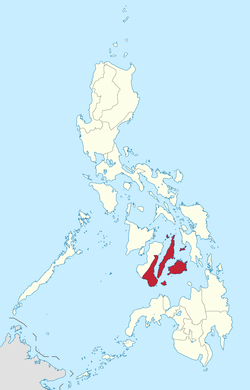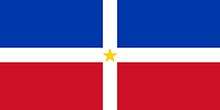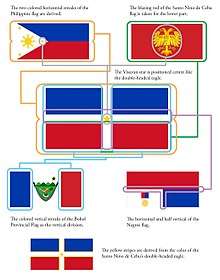Cebuano Visayan State
| Cebuano Visayan State Sugbuanong Estado | ||
|---|---|---|
| Proposed Federal State | ||
| ||
 | ||
| Capital | Cebu City | |
| Time zone | UTC+8 (PST) | |
The Cebuano Visayan State or the State of the Cebuano Visayas, also called Sugbuanong Estado, is a proposed democratic and republican federal state of the Philippines in a federal form of government, which reconfigures the non-political administrative region of Central Visayas, composed of Cebu, Bohol, Negros Oriental and Siquijor into a state. The idea was advanced by Philippine artist, author, and writer John Kingsley Pangan in his work Proposed Government and Constitution of the Cebuano Visayan Federal State.[1][2]

Background

The Philippines’ current government is highly centralized in the country's capital Manila. This overcentralized system seemed to hinder economic growth outside Luzon. Adding to the division is the cultural and linguistic imposition of the capital; the Tagalog-centric history, media and studies; and underrepresentation of the Visayas and Mindanao.[4] Those factors drove some Filipinos outside Luzon to aspire for a dual or, by extremity, a separate sovereignty.[5][6] In recent times, lawmakers have proposed a federal system as a compromise and one of the regions proposed is that of Central Visayas.[7][8]
Constitution and salient features
The proposed federal state for the Cebuano-speaking people in the provinces of Cebu, Negros Oriental, Bohol, and Siquijor, is one of many attempts if the 1987 Philippine Constitution is amended to accommodate a federal form of government since 2008.[9][10] The Cebuano Visayan State's capital is Cebu City.[11] Along with the proposed federal state, he details also in the same work a proposed State Constitution with some noticeable provisions:
Titular Sovereign of the State
Features of this proposed state is the constitutional recognition of the Lord Redeemer (i.e. Christ) as titular potentate of the state, as the Cebuano Visayans are known for their deep Christian fealty and devotion.[12][2] It pushes for a customary provision that accommodates the genuine belief of the Cebuano Visayan people in the universal kingship of Jesus Christ. Pangan argues its constitutionality is attested in the 1987 Philippine Constitution, which recognizes an all-powerful ("Almighty") and quintessential ruler of everything ("God") in its preamble. Further acknowledgement, according to him, is reflected in the Malolos Constitution ("Sovereign Legislator of the Universe"),[13] also the 1935, 1943, and 1973 Constitutions ("Divine Providence").[14][15][16] This constitution, in the same manner, recognizes uniquely in its provision the universal lordship but in a microcosm of a federal state. Consequently, a quasi-Christian federal state.[17][2]
Intellectual and Character-building
One of emphasis of the state constitution is supporting scientific and technological endeavors;[18] intellectual molding through mandatory workshops, trainings, and scientific experimentation; as well as encouraging debates for well-rounded citizens. It also emphasizes the character-building of the people.[19][2]
Cultural Prosperity
Another aim in the charter is to encourage a sort of cultural renaissance through learning and preservation of the Cebuano language and its dialects.[20] The cultivation of poetry, music, dance, drama, painting, sculpture, architecture, and literature.[21] Another way is the creation of a state department that is not only for development of housings and public structures, but also regulate and assist residential designs that is consistent with the modern Cebuano Visayan culture.[22] And finally, the creation of a state commission for historical research and preservation.[23][2]
Freedom of Information and a Transparency Commission
Pangan asserts that the right to access of information, save those that are sensitive or for security purposes, may pave way to a more corrupt-free government.[2][24] Thus, he proposes a unique independent constitutional office that deals with issues of government transparency that: (a) gather information and ready summarized and indexed background information of individuals who aspire to be elected in government office published in print and online during election period; (b) investigate a party, office or individual through a request of a citizen or a group, cutting through the red tapes; (c) and through the freedom of information apparatus, recommend administrative or criminal cases to the prosecutors, among others.[25]

Proposed flag
The proposed state flag made also by Pangan for the Cebuano Visayan State is called the Great Cebuan Cross. The cross represents the cultural Visayan Christianity with the color white meaning purity. The four rectangles made by the cross's division represents the four major island-provinces of Cebu, Bohol, Negros Oriental, and Siquijor. The first blue color signifies the sea as early Cebuano Visayans were seafarers, thusly, representing exploration and innovation. The second blue color represents justice, equality, as well as peace. The first red hue demonstrates the fervent devotion and faith of the people, while second red represents discipline, bravery and patriotism. The yellow star represents the Visayas geopolitical division placed at the center to denote the Central Visayas region[27]
The concept behind the flag was a combination of the flags of the Philippines, the Bohol Province, the banner of the 1898 Negrense revolution, and the flag of the Santo Niño de Cebu.[28]
Gallery
Design alternatives of the Cebuano Visayan State Flag:[29]
 State Flag Variant 1
State Flag Variant 1 State Flag Variant 2
State Flag Variant 2 State Flag Variant 3
State Flag Variant 3 State Flag Variant 4
State Flag Variant 4 State Flag Variant 5
State Flag Variant 5 State Flag Variant 6
State Flag Variant 6
See also
References
- ↑ John Kingsley Pangan (2016) Proposed Government and Constitution of the Cebuano Visayan Federal State. p. 9.
- 1 2 3 4 5 6 Bogtrotter, M. (2017). Analysis of Pangan’s Proposed Christian Federal State Compared with the Proposed Bangsamoro. Mendeley - Elsevier, 1-2.
- ↑ John Kingsley Pangan (2016) Proposed Government and Constitution of the Cebuano Visayan Federal State. p. 13.
- ↑ 'Imperial Manila' takes growth in unitary system. Philippine Information Agency.
- ↑ Pangan 2016, p. 4
- ↑ Yusingco, M. L. (6 August 2016). "Federalism and 'Imperial Manila'". Philippine Daily Inquirer. Retrieved 26 June 2018.
- ↑ 14th Philippine Congress, Senate Joint Resolution No. 10
- ↑ Francisco, Katerina (17 June 2016). "Federalism in PH: 81 senators, 11 federal states?". Rappler. Retrieved 4 July 2018.
- ↑ Mosqueda, M. W., Jr. (3 June 2016). Cebu mayors back federal government. Manila Bulletin. Retrieved from https://www.pressreader.com/philippines/manila-bulletin/20160603/281805693187185
- ↑ 13 Central Visayas reps seek Con-Assembly. (7 May 2008). GMA News Online. Retrieved from http://www.gmanetwork.com/news/news/regions/93703/13-central-visayas-reps-seek-con-assembly/story/
- ↑ Pangan, 2016, p. 8.
- ↑ Pangan, 2016, Constitution, Article I, Section 3."The Cebuano Visayans from antiquity until the formation of the Philippine nation have always profoundly integrated the faith to their cultures and traditions, thus, emanating from the identity, fealty and devotion of the people, and in imploration of aid, the Lord Redeemer shall forever be recognized customarily as the potentate of the State."
- ↑ Documents of independence. (n.d.). Retrieved 2 July 2018, from http://malacanang.gov.ph/7827-documents-of-independence//
- ↑ The 1935 Philippine Constitution. Philippine Official Gazette.
- ↑ The 1943 Constitution. Philippine Official Gazette.
- ↑ The 1973 Philippine Constitution. Philippine Official Gazette.
- ↑ Pangan, 2016, 11.
- ↑ Article VI, Section 1a of the Proposed Constitution
- ↑ Article IV, Section 13b – d, & Section 41 (Presidential Version)
- ↑ Article I, Section 6-7 (Parliamentary Version)
- ↑ Article VII, Section b (Parliamentary Version).
- ↑ Article IV Section 30-34 (Parliamentary Version).
- ↑ Ibid., Section 35- 39
- ↑ Derived and cross-referenced with Presidential Executive Order No. 02, s. 2016.
- ↑ Pangan, 2016. Article on Transparency in Public Office.
- ↑ Pangan, 2016, p.17
- ↑ Taken verbatim. Pangan, 2016, p. 13
- ↑ Pangan, 2016, 15–18.
- ↑ Pangan, 2016, p. 13-14, 19.
Further reading
Pangan, John Kingsley, Proposed Government and Constitution of the Cebuano Visayan Federal State (Federal-Presidential Version), Cebu City: 2016 – mendeley.com / academia.edu.
Pangan, John Kingsley, Proposed Government and Constitution of the Cebuano Visayan Federal State (Federal-Parliamentary Version), Cebu City: 2016 – mendeley.com / academia.edu.